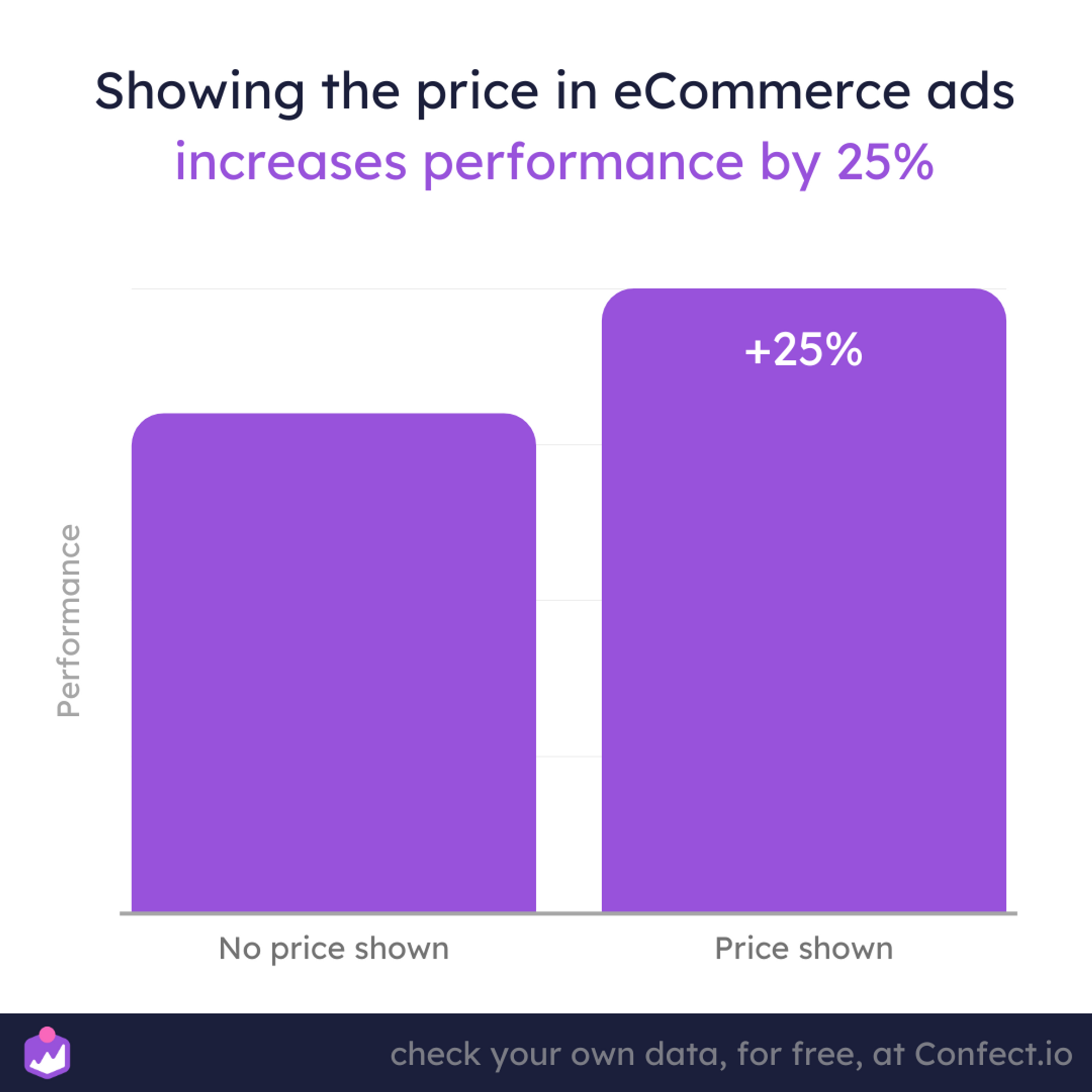Increase performance on your e-commerce ads with price
January 16, 2022
When you're trying to sell something, there are two main things to think about: the value (all the good stuff about the product) and the sacrifice (the price and cost).
Most advertisers focus on telling people all the great things about their products, but they're often hesitant to talk about the price.
They don't want to turn people off, so they leave the price out of the ad and make it a surprise for when people get to the product page.
But here's the thing: does the price actually make the ad less effective, or is it the other way around?
Let’s dive in and take a look!
Showing the price in eCommerce content increases performance by 25%
Contrary to popular belief, we found that ads that show the product's price perform 25% better than ads that don't, on average!
People might think that seeing the price will turn them off, but that's only true if the product doesn't offer enough value for the cost.
Most of the time, showing the price is a good thing.
If people know the price before they click on the ad, it'll help them decide if the value/price ratio is worth it.
And if they think it is, they'll be more likely to buy because they won't have as many doubts.
So just by including the price in your ad, you could see a 25% boost in performance.

Showing the price in your ads is one thing, but when to show the ads is another aspect you should keep in mind.
Showing the price in your ad increases performance on and after payday
Believe it or not, we found that there are only three days in a month when showing the price in an ad is worse than not showing it, and even then, it's not by much.
But from the 28th of the month through the 17th of the next month, including the price in your ad can make a big difference in performance.
The reason for this might have something to do with payday - when people have just gotten their salary, they're more likely to make purchases.
If they know the price before they click on the ad, they can see if it fits into their budget faster and decide to buy before they even visit the product page.
Knowing when the best times to show the price can help boost your ad performance.
.png)
So far, we've talked about when and why to show the price in an ad.
But what if you're running a sale campaign?
Showing the percentage saved performs 68% better than sale ads showing price savings
If you're running a sale campaign, there's another thing you can do to improve performance.
Simply showing the savings as a percentage instead of in currency performs 68% better!
For example, "30$ (40% off)" will do better than "30$ (20$ off)".
This is probably due to the fact that most people just understand percentages better and can relate to them more easily.
They can instantly think about spending 60$ instead of 100$, or 600$ instead of 1000$.
That's why most discounts are expressed as a percentage - it's easier to compare different products too.
It's usually not as effective to express discounts in currency because it's harder for people to understand and relate to.
So if you want a possible boost in your sale ads performance, try showing the percentage instead of currency.

Keep these ad pricing insights in mind when running your ads
Some advertisers are hesitant to show the price right away because they're worried it might turn buyers off.
But not disclosing the price until later can be a bigger problem.
If a customer doesn't have a good sense of the price and then finds out it's too expensive for them, they'll probably just leave your product page.
It's a good idea to include the price in your ad to set expectations, especially on payday or just after.
And if you're running a sale, don't forget to show the savings as a percentage - it's easier for people to understand and relate to than just showing it in a currency.
You can easily do this by trying a free demo of Confect today!
With Confect, you can instantly design, edit, and customize your product ads to look better, and stand out from your competitors!
Keep these things in mind the next time you're running your ecommerce ads and see what results you get!
More to read
This article focuses purely on the impact of price in eCommerce content. To learn how to optimize your ads further, read these blogs:
Data section
The dataset from this article is based on 5.6B impressions and 10.3K pieces of individual content on Meta (Facebook) platforms. It takes into account data from all countries and industries, with the campaign objective of Conversions. The period is from 1. September 2021 - 6. July 2022.
The insights were filtered to only include data regarding “price in content”.
Numbers are looking at correlation only, not causation. Remember to check your own data: numbers for different brands, industries, and contexts will vary.
If you were intrigued about a specific insight, you can go in-depth into the various dimensions and how data can be segmented in Confect, here.
